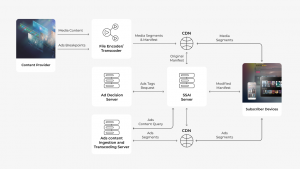
After more than 40 years of operation, DTVE is closing its doors and our website will no longer be updated daily. Thank you for all of your support.
Dark sides of dynamic ad insertion: is there a way to confront them?
Oxagile’s solution architect for video systems and targeted TV advertising expert Maxim Koshel lifts the lid on the ins and the outs of dynamic ad insertion.
The ‘skip’ button, serving as valuable feedback for advertisers, still remains a nightmare, as it stops thousands of potential target viewers from swallowing the hook of the ad story.
Dynamic ad insertion, or server-side ad insertion (SSAI), allows streaming operators to forget forget about latency issues and ad blockers, while letting them sell one ad inventory millions of times and request extra money for targeted, more effective ad impressions.
Stay alert though: pure dynamic ad insertion is not a panacea from all ‘diseases’. Specifically, instant control of advertising efficiency or viewing feedback on the NextGen TV ad is not covered by this approach.
Dynamic ad insertion workflow: are there any stumbling blocks?
Expert comment
“The generic challenge of SSAI is that it requires a highly scalable architecture. This is especially critical for broadcasters who have to deal with the sharp peaks in demand caused by world-famous sports or trending TV shows.
When the events are underway, it’s hard to predict the number of concurrent users, as it may vary. Specifically, the viewership of popular games often increases by hundreds of thousands of new people during the last few minutes.
One of the most effective ways for broadcasters to meet audience demands is cloud-based video processing with the SSAI integration.”
Costs bite: hyper-personalisation and stratospheric prices go hand in hand
If there is a need to share an event with a one-million audience around the world, a streaming operator adopts a multi-level content delivery network strategy, opting for geographically-distributed servers. They deliver content faster to end users, having local edge nodes in each country where consumers reside.
While an Amsterdam citizen absorbs a football match via a Dutch server and data centre, football fans from Paris are provided with a sports streaming experience through the French edge node.
Imagine you and your neighbour sitting behind the screen and choosing the same football match to watch. If you are the first to connect, your neighbour will get a cached version of the content.
But what happens when it comes to the ads, provided that you’re a fan of fishing and your neighbor is keen on photography?
Expert comment
“Caching doesn’t work here, as personalised advertising requests unique traffic for each user.
What are the billing terms? CDNs will charge additional costs, as the traffic volume increases dramatically, covering inter-region, inter-company, and inter-communication traffic.
No matter how the integration with dynamic ad insertion is going – whether an operator buys an SSAI vendor or decides on using cloud services – unique playlists and no caching dictate an enormously expensive CDN/Cloud setup.
The first option to reduce advertising costs 1,000 times is to combine one million users into the groups of 1,000 cohorts according to particular criteria, such as regional, social, age, etc. and show them one and the same ads.
Another scenario for cutting costs is ad prefetching, which allows scheduling the ads. As determining an ad break length in advance is required, the other side of the coin is the unpredictability of end user behaviour. No one knows whether they will watch a football match from the beginning to the end or switch it off, which means that already scheduled ad slots remain unseen. Anyway, it will save more money in comparison with the unique traffic.”
Ad effectiveness: how to track the audience feedback
You’ll never know how viewers will react to the ad, even if the thing or service sold is something that’s close to their needs. Advertisers want to pay for the ads that get viewability, clicks, and visits, not just for ad impressions. While the CSAI method has no issues with counting the statistics (unless it’s being blocked), how can SSAI provide stats on the desired ad being viewed given the fact that an ad is stitched directly into the stream and client control is missing?
Expert comment
“The ‘skip’ button serves as the feedback for the instant transformation of advertising campaigns. With SSAI comes a tracking issue – there’s no guarantee that users have been watching the ad.
Depending on tech, player implementation, or browsers, there could be issues with the ad delivery. One of the common cases is pausing – if it takes a couple of minutes, a client may not see the whole ad.”
Here comes the dilemma: SSAI or CSAI?
For SSAI, be ready for it to hit you in the pocket.
In case of CSAI, ads can be simply blocked by viewers. Besides, be aware of integration and maintenance costs for each platform, like the web, mobile, smart TVs, STBs, etc.
Or is there another alternative?
Expert comment
“Why is YouTube so popular among advertisers? Thanks to their own video service and video player, the content they have control over, and closed infrastructure, they manage to introduce comprehensive feedback.
So, today we’re moving to a hybrid ad insertion system where a player, supporting DASH or HLS playback, is responsible for tracking, with metadata transferred from server to client.
Hybrid system implementation is half the battle – app developers should understand well with how advertising works, beyond creating a proper business logic.
To instantly provide an advertiser with the feedback 15 minutes after the ad is being viewed, advertising indexing, impression tracking, and programmatic insertion concepts are must-have competencies.”
Manifest manipulation: does everything go without a hitch?
No more multistage ad transcoding process to enable ad insertion into the content – a quick and easy operation called manifest manipulation stitches the ad into the video stream.
It has gained utmost popularity over other methods of delivering personalised advertising experience thanks to the ability to warn a player about the issues with an ad. If there’s anything wrong with the ad’s transcoding or availability, fine-tuning and resuming playback won’t take long.
Being the easiest method to handle, manifest manipulation still can’t be considered faultless, as it has the same restrictions as the other options.
Expert comment
“To support live scenarios, manifest manipulation allocates some time for buffering. The exact settings are controlled by the operator. Here could be nuances with the ad segment duration – if the player requests and shows every other ad segment half a minute earlier due to the incorrect segment duration (it’s a common thing with advertisers who tend to miscalculate the length of the ad chunk), you’ll quickly run out of buffer space. This can result in playback problems, sometimes without having a chance to resume playing the stream. It’s an issue related to content, not the technology, though.”
NextGen TV and dynamic ad insertion: is it a match?
Thanks to its dedicated return channel possibilities, NextGen TV opens up space for monitoring user behaviour and sending the statistics back to broadcasters. Using the NextGen TV standard, the latter don’t need to rely solely on surveys or dedicated, closely monitored audiences to identify the most popular shows.
What about addressable advertising? Is it possible to pair NextGen TV and dynamic ad insertion, competing with OTT streaming?
Expert comment
“Dynamic ad insertion in combination with NextGen TV is not about real-time. To avoid the risk that there’s no internet connection, to implement dynamic ad insertion you need either great bandwidth or multiplexing.
Let’s make it simpler: advertisers have to prepare in advance the advertising they want to show during some large-scale event, like the Super Bowl, covering over 150 million simultaneous viewers, and send the ads in chunks. The ad server stores and then distributes ads to the right users at the right time.
What’s good? NextGen TV is connected with the client, which enables ad-related data from the client device being transferred back to the server.
What’s imperfect? It’s impossible to instantly get the feedback on the ad viewing experience, which is a pain for an advertiser, as the sooner you get this info, the more successfully you recalibrate the next advertising slot. The tandem of NextGen TV and dynamic ad insertion won’t allow this option.
Based on the above, operators are likely to adopt the role of advertisers, along with ad tracking.”
For more information visit www.oxagile.com
This is sponsored content.




